Clinical Placement Reflection: NMC Code of Conduct Analysis
VerifiedAdded on 2022/12/27
|6
|1636
|1
Report
AI Summary
This report reflects on a clinical placement experience in an acute stroke unit, where a student nurse encountered a challenging situation involving a 63-year-old female patient experiencing a stroke. The student, initially apprehensive due to personal perceptions about stroke outcomes, struggled to communicate effectively with the patient, leading to a violent outburst and the application of restraints. The report uses the Gibbs reflective cycle to analyze the incident, detailing the student's feelings, evaluation of the situation, and the actions taken. It critically examines the event in relation to the NMC code of conduct, highlighting areas where professional standards were met and where improvements are needed, particularly concerning patient safety, communication, and the ethical use of restraints. The conclusion identifies the student's stereotypic attitude and action plan to eliminate it. The report emphasizes the importance of patient-centered care and the need to uphold patient dignity and well-being.
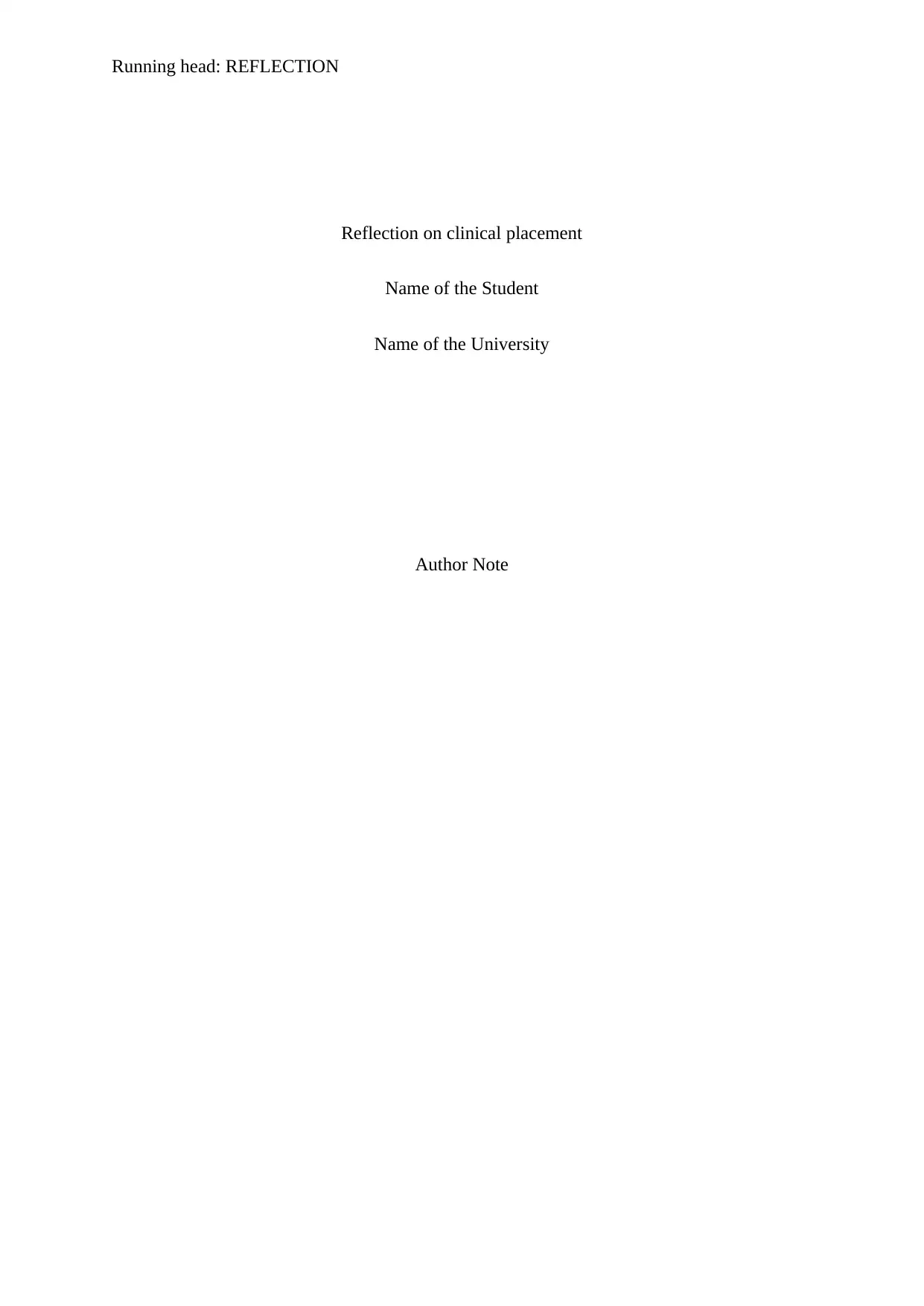
Running head: REFLECTION
Reflection on clinical placement
Name of the Student
Name of the University
Author Note
Reflection on clinical placement
Name of the Student
Name of the University
Author Note
Paraphrase This Document
Need a fresh take? Get an instant paraphrase of this document with our AI Paraphraser
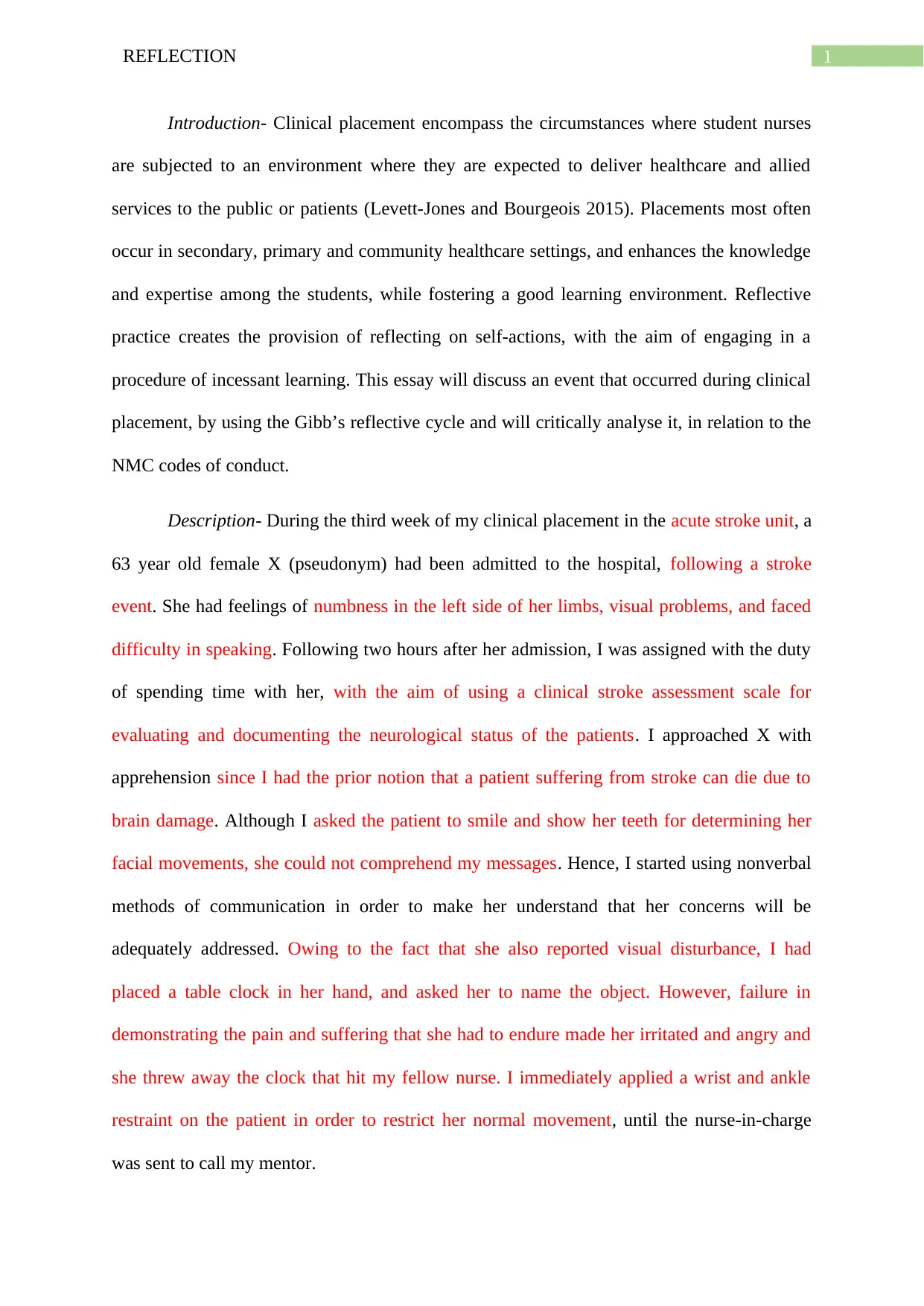
1REFLECTION
Introduction- Clinical placement encompass the circumstances where student nurses
are subjected to an environment where they are expected to deliver healthcare and allied
services to the public or patients (Levett-Jones and Bourgeois 2015). Placements most often
occur in secondary, primary and community healthcare settings, and enhances the knowledge
and expertise among the students, while fostering a good learning environment. Reflective
practice creates the provision of reflecting on self-actions, with the aim of engaging in a
procedure of incessant learning. This essay will discuss an event that occurred during clinical
placement, by using the Gibb’s reflective cycle and will critically analyse it, in relation to the
NMC codes of conduct.
Description- During the third week of my clinical placement in the acute stroke unit, a
63 year old female X (pseudonym) had been admitted to the hospital, following a stroke
event. She had feelings of numbness in the left side of her limbs, visual problems, and faced
difficulty in speaking. Following two hours after her admission, I was assigned with the duty
of spending time with her, with the aim of using a clinical stroke assessment scale for
evaluating and documenting the neurological status of the patients. I approached X with
apprehension since I had the prior notion that a patient suffering from stroke can die due to
brain damage. Although I asked the patient to smile and show her teeth for determining her
facial movements, she could not comprehend my messages. Hence, I started using nonverbal
methods of communication in order to make her understand that her concerns will be
adequately addressed. Owing to the fact that she also reported visual disturbance, I had
placed a table clock in her hand, and asked her to name the object. However, failure in
demonstrating the pain and suffering that she had to endure made her irritated and angry and
she threw away the clock that hit my fellow nurse. I immediately applied a wrist and ankle
restraint on the patient in order to restrict her normal movement, until the nurse-in-charge
was sent to call my mentor.
Introduction- Clinical placement encompass the circumstances where student nurses
are subjected to an environment where they are expected to deliver healthcare and allied
services to the public or patients (Levett-Jones and Bourgeois 2015). Placements most often
occur in secondary, primary and community healthcare settings, and enhances the knowledge
and expertise among the students, while fostering a good learning environment. Reflective
practice creates the provision of reflecting on self-actions, with the aim of engaging in a
procedure of incessant learning. This essay will discuss an event that occurred during clinical
placement, by using the Gibb’s reflective cycle and will critically analyse it, in relation to the
NMC codes of conduct.
Description- During the third week of my clinical placement in the acute stroke unit, a
63 year old female X (pseudonym) had been admitted to the hospital, following a stroke
event. She had feelings of numbness in the left side of her limbs, visual problems, and faced
difficulty in speaking. Following two hours after her admission, I was assigned with the duty
of spending time with her, with the aim of using a clinical stroke assessment scale for
evaluating and documenting the neurological status of the patients. I approached X with
apprehension since I had the prior notion that a patient suffering from stroke can die due to
brain damage. Although I asked the patient to smile and show her teeth for determining her
facial movements, she could not comprehend my messages. Hence, I started using nonverbal
methods of communication in order to make her understand that her concerns will be
adequately addressed. Owing to the fact that she also reported visual disturbance, I had
placed a table clock in her hand, and asked her to name the object. However, failure in
demonstrating the pain and suffering that she had to endure made her irritated and angry and
she threw away the clock that hit my fellow nurse. I immediately applied a wrist and ankle
restraint on the patient in order to restrict her normal movement, until the nurse-in-charge
was sent to call my mentor.
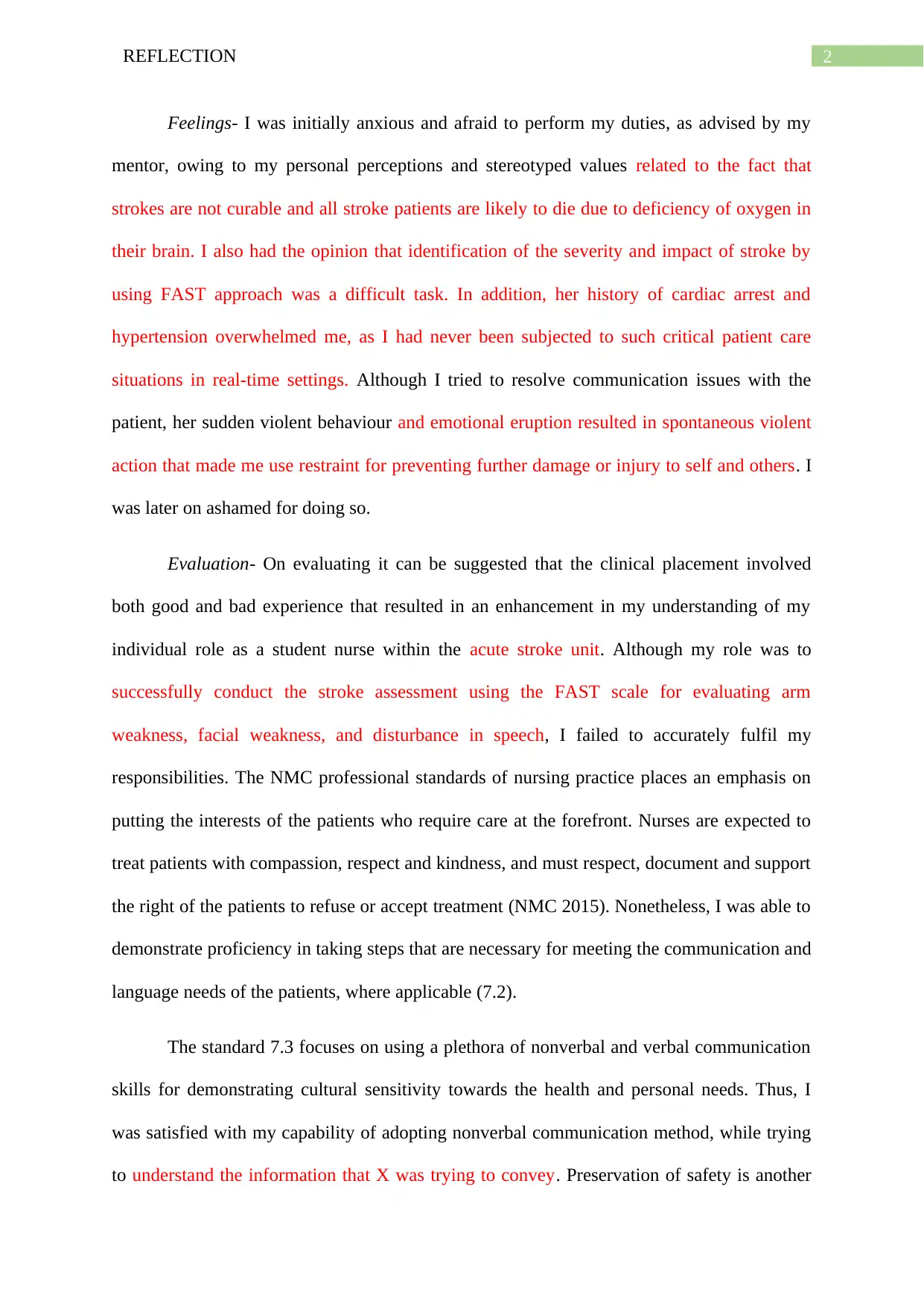
2REFLECTION
Feelings- I was initially anxious and afraid to perform my duties, as advised by my
mentor, owing to my personal perceptions and stereotyped values related to the fact that
strokes are not curable and all stroke patients are likely to die due to deficiency of oxygen in
their brain. I also had the opinion that identification of the severity and impact of stroke by
using FAST approach was a difficult task. In addition, her history of cardiac arrest and
hypertension overwhelmed me, as I had never been subjected to such critical patient care
situations in real-time settings. Although I tried to resolve communication issues with the
patient, her sudden violent behaviour and emotional eruption resulted in spontaneous violent
action that made me use restraint for preventing further damage or injury to self and others. I
was later on ashamed for doing so.
Evaluation- On evaluating it can be suggested that the clinical placement involved
both good and bad experience that resulted in an enhancement in my understanding of my
individual role as a student nurse within the acute stroke unit. Although my role was to
successfully conduct the stroke assessment using the FAST scale for evaluating arm
weakness, facial weakness, and disturbance in speech, I failed to accurately fulfil my
responsibilities. The NMC professional standards of nursing practice places an emphasis on
putting the interests of the patients who require care at the forefront. Nurses are expected to
treat patients with compassion, respect and kindness, and must respect, document and support
the right of the patients to refuse or accept treatment (NMC 2015). Nonetheless, I was able to
demonstrate proficiency in taking steps that are necessary for meeting the communication and
language needs of the patients, where applicable (7.2).
The standard 7.3 focuses on using a plethora of nonverbal and verbal communication
skills for demonstrating cultural sensitivity towards the health and personal needs. Thus, I
was satisfied with my capability of adopting nonverbal communication method, while trying
to understand the information that X was trying to convey. Preservation of safety is another
Feelings- I was initially anxious and afraid to perform my duties, as advised by my
mentor, owing to my personal perceptions and stereotyped values related to the fact that
strokes are not curable and all stroke patients are likely to die due to deficiency of oxygen in
their brain. I also had the opinion that identification of the severity and impact of stroke by
using FAST approach was a difficult task. In addition, her history of cardiac arrest and
hypertension overwhelmed me, as I had never been subjected to such critical patient care
situations in real-time settings. Although I tried to resolve communication issues with the
patient, her sudden violent behaviour and emotional eruption resulted in spontaneous violent
action that made me use restraint for preventing further damage or injury to self and others. I
was later on ashamed for doing so.
Evaluation- On evaluating it can be suggested that the clinical placement involved
both good and bad experience that resulted in an enhancement in my understanding of my
individual role as a student nurse within the acute stroke unit. Although my role was to
successfully conduct the stroke assessment using the FAST scale for evaluating arm
weakness, facial weakness, and disturbance in speech, I failed to accurately fulfil my
responsibilities. The NMC professional standards of nursing practice places an emphasis on
putting the interests of the patients who require care at the forefront. Nurses are expected to
treat patients with compassion, respect and kindness, and must respect, document and support
the right of the patients to refuse or accept treatment (NMC 2015). Nonetheless, I was able to
demonstrate proficiency in taking steps that are necessary for meeting the communication and
language needs of the patients, where applicable (7.2).
The standard 7.3 focuses on using a plethora of nonverbal and verbal communication
skills for demonstrating cultural sensitivity towards the health and personal needs. Thus, I
was satisfied with my capability of adopting nonverbal communication method, while trying
to understand the information that X was trying to convey. Preservation of safety is another
⊘ This is a preview!⊘
Do you want full access?
Subscribe today to unlock all pages.

Trusted by 1+ million students worldwide
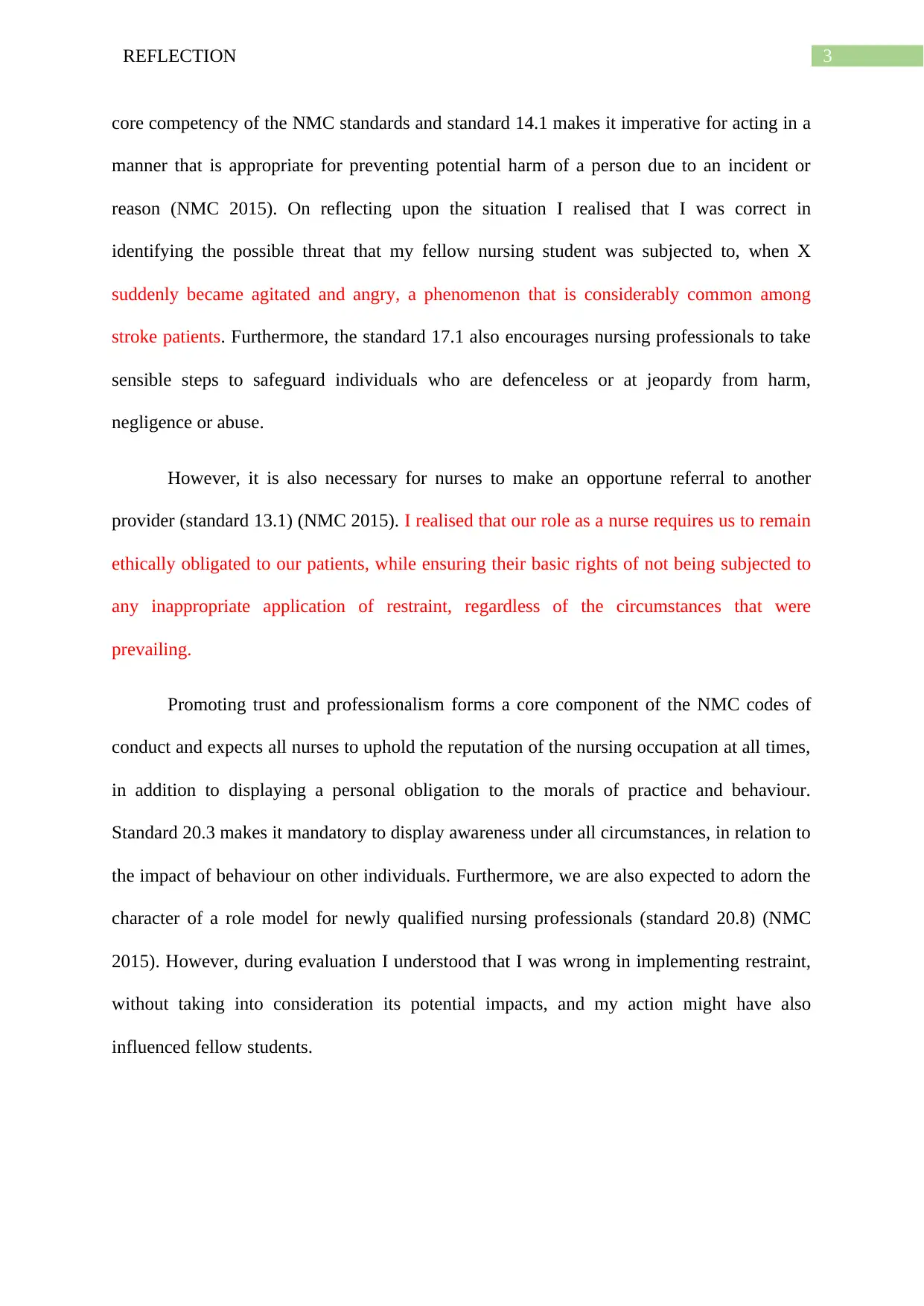
3REFLECTION
core competency of the NMC standards and standard 14.1 makes it imperative for acting in a
manner that is appropriate for preventing potential harm of a person due to an incident or
reason (NMC 2015). On reflecting upon the situation I realised that I was correct in
identifying the possible threat that my fellow nursing student was subjected to, when X
suddenly became agitated and angry, a phenomenon that is considerably common among
stroke patients. Furthermore, the standard 17.1 also encourages nursing professionals to take
sensible steps to safeguard individuals who are defenceless or at jeopardy from harm,
negligence or abuse.
However, it is also necessary for nurses to make an opportune referral to another
provider (standard 13.1) (NMC 2015). I realised that our role as a nurse requires us to remain
ethically obligated to our patients, while ensuring their basic rights of not being subjected to
any inappropriate application of restraint, regardless of the circumstances that were
prevailing.
Promoting trust and professionalism forms a core component of the NMC codes of
conduct and expects all nurses to uphold the reputation of the nursing occupation at all times,
in addition to displaying a personal obligation to the morals of practice and behaviour.
Standard 20.3 makes it mandatory to display awareness under all circumstances, in relation to
the impact of behaviour on other individuals. Furthermore, we are also expected to adorn the
character of a role model for newly qualified nursing professionals (standard 20.8) (NMC
2015). However, during evaluation I understood that I was wrong in implementing restraint,
without taking into consideration its potential impacts, and my action might have also
influenced fellow students.
core competency of the NMC standards and standard 14.1 makes it imperative for acting in a
manner that is appropriate for preventing potential harm of a person due to an incident or
reason (NMC 2015). On reflecting upon the situation I realised that I was correct in
identifying the possible threat that my fellow nursing student was subjected to, when X
suddenly became agitated and angry, a phenomenon that is considerably common among
stroke patients. Furthermore, the standard 17.1 also encourages nursing professionals to take
sensible steps to safeguard individuals who are defenceless or at jeopardy from harm,
negligence or abuse.
However, it is also necessary for nurses to make an opportune referral to another
provider (standard 13.1) (NMC 2015). I realised that our role as a nurse requires us to remain
ethically obligated to our patients, while ensuring their basic rights of not being subjected to
any inappropriate application of restraint, regardless of the circumstances that were
prevailing.
Promoting trust and professionalism forms a core component of the NMC codes of
conduct and expects all nurses to uphold the reputation of the nursing occupation at all times,
in addition to displaying a personal obligation to the morals of practice and behaviour.
Standard 20.3 makes it mandatory to display awareness under all circumstances, in relation to
the impact of behaviour on other individuals. Furthermore, we are also expected to adorn the
character of a role model for newly qualified nursing professionals (standard 20.8) (NMC
2015). However, during evaluation I understood that I was wrong in implementing restraint,
without taking into consideration its potential impacts, and my action might have also
influenced fellow students.
Paraphrase This Document
Need a fresh take? Get an instant paraphrase of this document with our AI Paraphraser
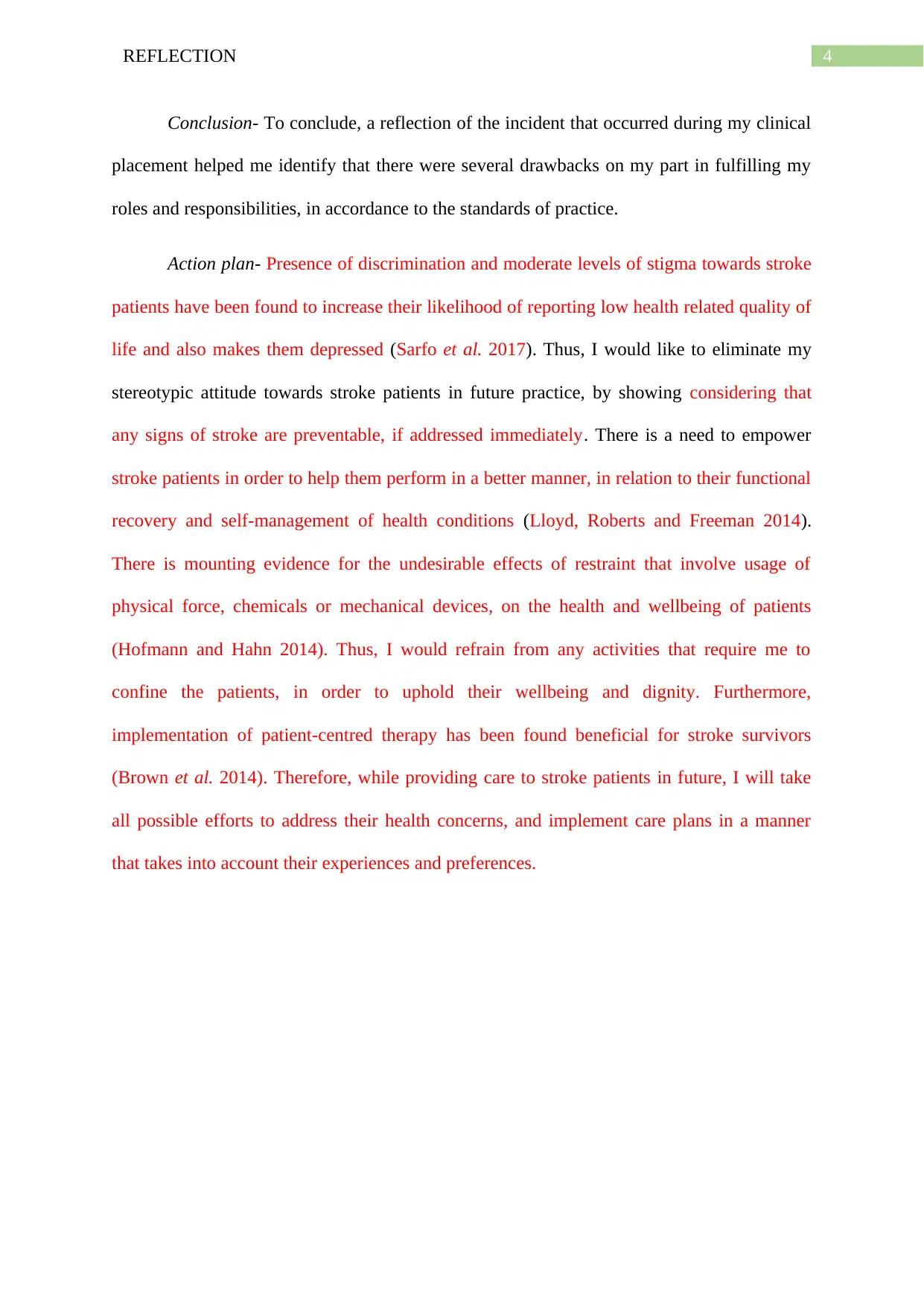
4REFLECTION
Conclusion- To conclude, a reflection of the incident that occurred during my clinical
placement helped me identify that there were several drawbacks on my part in fulfilling my
roles and responsibilities, in accordance to the standards of practice.
Action plan- Presence of discrimination and moderate levels of stigma towards stroke
patients have been found to increase their likelihood of reporting low health related quality of
life and also makes them depressed (Sarfo et al. 2017). Thus, I would like to eliminate my
stereotypic attitude towards stroke patients in future practice, by showing considering that
any signs of stroke are preventable, if addressed immediately. There is a need to empower
stroke patients in order to help them perform in a better manner, in relation to their functional
recovery and self-management of health conditions (Lloyd, Roberts and Freeman 2014).
There is mounting evidence for the undesirable effects of restraint that involve usage of
physical force, chemicals or mechanical devices, on the health and wellbeing of patients
(Hofmann and Hahn 2014). Thus, I would refrain from any activities that require me to
confine the patients, in order to uphold their wellbeing and dignity. Furthermore,
implementation of patient-centred therapy has been found beneficial for stroke survivors
(Brown et al. 2014). Therefore, while providing care to stroke patients in future, I will take
all possible efforts to address their health concerns, and implement care plans in a manner
that takes into account their experiences and preferences.
Conclusion- To conclude, a reflection of the incident that occurred during my clinical
placement helped me identify that there were several drawbacks on my part in fulfilling my
roles and responsibilities, in accordance to the standards of practice.
Action plan- Presence of discrimination and moderate levels of stigma towards stroke
patients have been found to increase their likelihood of reporting low health related quality of
life and also makes them depressed (Sarfo et al. 2017). Thus, I would like to eliminate my
stereotypic attitude towards stroke patients in future practice, by showing considering that
any signs of stroke are preventable, if addressed immediately. There is a need to empower
stroke patients in order to help them perform in a better manner, in relation to their functional
recovery and self-management of health conditions (Lloyd, Roberts and Freeman 2014).
There is mounting evidence for the undesirable effects of restraint that involve usage of
physical force, chemicals or mechanical devices, on the health and wellbeing of patients
(Hofmann and Hahn 2014). Thus, I would refrain from any activities that require me to
confine the patients, in order to uphold their wellbeing and dignity. Furthermore,
implementation of patient-centred therapy has been found beneficial for stroke survivors
(Brown et al. 2014). Therefore, while providing care to stroke patients in future, I will take
all possible efforts to address their health concerns, and implement care plans in a manner
that takes into account their experiences and preferences.

5REFLECTION
References
Brown, M., Levack, W., McPherson, K.M., Dean, S.G., Reed, K., Weatherall, M. and Taylor,
W.J., 2014. Survival, momentum, and things that make me “me”: patients’ perceptions of
goal setting after stroke. Disability and rehabilitation, 36(12), pp.1020-1026.
Hofmann, H. and Hahn, S., 2014. Characteristics of nursing home residents and physical
restraint: a systematic literature review. Journal of Clinical Nursing, 23(21-22), pp.3012-
3024.
Levett-Jones, T. and Bourgeois, S., 2015. The clinical placement-e-book: An essential guide
for nursing students. Elsevier Health Sciences.
Lloyd, A., Roberts, A.R. and Freeman, J.A., 2014. ‘Finding a balance’in involving patients in
goal setting early after stroke: A physiotherapy perspective. Physiotherapy Research
International, 19(3), pp.147-157.
Nursing and Midwifery Council., 2015. The Code Professional standards of practice and
behaviour for nurses, midwives and nursing associates. [online] Available at:
https://www.nmc.org.uk/globalassets/sitedocuments/nmc-publications/nmc-code.pdf
[Accessed 02 May. 2019]
Sarfo, F.S., Nichols, M., Qanungo, S., Teklehaimanot, A., Singh, A., Mensah, N., Saulson,
R., Gebregziabher, M., Ezinne, U., Owolabi, M. and Jenkins, C., 2017. Stroke-related stigma
among West Africans: patterns and predictors. Journal of the neurological sciences, 375,
pp.270-274.
References
Brown, M., Levack, W., McPherson, K.M., Dean, S.G., Reed, K., Weatherall, M. and Taylor,
W.J., 2014. Survival, momentum, and things that make me “me”: patients’ perceptions of
goal setting after stroke. Disability and rehabilitation, 36(12), pp.1020-1026.
Hofmann, H. and Hahn, S., 2014. Characteristics of nursing home residents and physical
restraint: a systematic literature review. Journal of Clinical Nursing, 23(21-22), pp.3012-
3024.
Levett-Jones, T. and Bourgeois, S., 2015. The clinical placement-e-book: An essential guide
for nursing students. Elsevier Health Sciences.
Lloyd, A., Roberts, A.R. and Freeman, J.A., 2014. ‘Finding a balance’in involving patients in
goal setting early after stroke: A physiotherapy perspective. Physiotherapy Research
International, 19(3), pp.147-157.
Nursing and Midwifery Council., 2015. The Code Professional standards of practice and
behaviour for nurses, midwives and nursing associates. [online] Available at:
https://www.nmc.org.uk/globalassets/sitedocuments/nmc-publications/nmc-code.pdf
[Accessed 02 May. 2019]
Sarfo, F.S., Nichols, M., Qanungo, S., Teklehaimanot, A., Singh, A., Mensah, N., Saulson,
R., Gebregziabher, M., Ezinne, U., Owolabi, M. and Jenkins, C., 2017. Stroke-related stigma
among West Africans: patterns and predictors. Journal of the neurological sciences, 375,
pp.270-274.
⊘ This is a preview!⊘
Do you want full access?
Subscribe today to unlock all pages.

Trusted by 1+ million students worldwide
1 out of 6
Related Documents
Your All-in-One AI-Powered Toolkit for Academic Success.
+13062052269
info@desklib.com
Available 24*7 on WhatsApp / Email
![[object Object]](/_next/static/media/star-bottom.7253800d.svg)
Unlock your academic potential
Copyright © 2020–2025 A2Z Services. All Rights Reserved. Developed and managed by ZUCOL.





